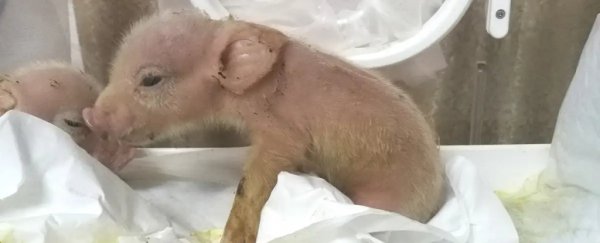Pigs engineered to have a small amount of monkey cells have been brought to full term and were even born alive, surviving for a few days after birth. Although the piglets died, it is claimed the experiment - performed in China - marks a major milestone for the future of lab-grown organs.
"This is the first report of full-term pig-monkey chimeras," Tang Hai of the State Key Laboratory of Stem Cell and Reproductive Biology in Beijing told New Scientist.
The research is part of an ongoing effort to develop animals - whether they are sheep or pigs - that can grow human organs we could then harvest for transplants, a process called xenogeneic organogenesis.
Research has been done on both pig and sheep embryos with transplanted human stem cells; in both cases, the embryos continued to develop until the experiment was deliberately terminated.
That's because, due to ethical concerns, these chimeras - organisms that incorporate the genetic material of another species - cannot be cultivated or studied in the later stages of embryonic development. Some scientists worry that some of the human stem cells could end up in other parts of the animal or even in its brain, with unintended consequences.
For that reason, in this experiment the team used stem cells from crab-eating macaques (Macaca fascicularis). These were imbued with fluorescent proteins so that they would glow under fluorescent light, and derived to produce fluorescing embryonic cells.
These cells were then injected into over 4,000 five-day-old pig embryos fertilised using IVF; the modified pig embryos were subsequently implanted into sows.
This fiddly and painstaking work produced just 10 piglets that made it to full term and were born alive. And only two of these were chimeric, with between one in 1,000 and one in 10,000 functional monkey cells to pig cells.
The monkey cells had migrated to the heart, liver, lungs, spleen and skin of the piglet hosts, but were not found in other organs, such as testes and ovaries, due to the low rate of chimerism, the researchers said.
Sadly, before a week was out, the piglets died - not just the two chimeras, but the other eight normal piglets, too. Because all the pigs died, Hai told New Scientist, the cause of death likely had less to do with chimerism, and more to do with IVF - a procedure that is notoriously tricky in pigs.
The low chimerism rate is also somewhat discouraging. However, the researchers remain optimistic. Although the birth rate was low, and the pigs didn't survive, the team now has a wealth of data they can apply to future experiments.
The scientists are planning to try again, increasing the chimeric cell ratio. And they believe their data may help other scientists working in the field.
"Here, we have used monkey cells to explore the potential of reconstructing chimeric human organs in a large animal model," they wrote in their paper.
"We believe this work will facilitate the development of xenogeneic organogenesis by providing a better understanding of the processes of xenogeneic recognition, fate determination, and the proliferation and differentiation of primate stem cells during porcine development.
"The findings could pave the way toward overcoming the obstacles in the re-engineering of heterogeneous organs and achieve the ultimate goal of human organ reconstruction in a large animal."
The research has been published in Protein & Cell.
